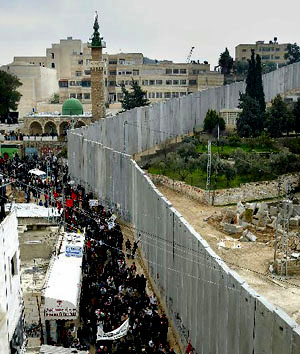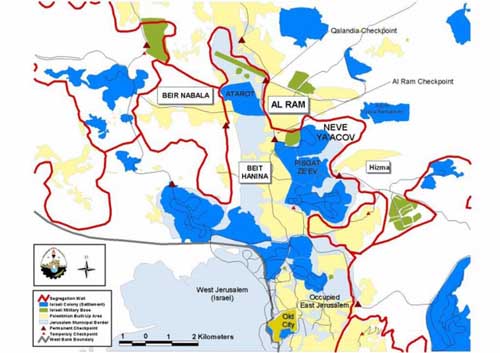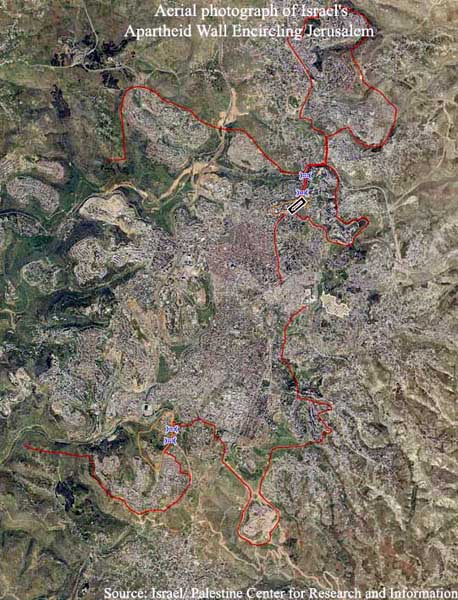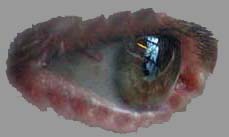Our Spirit is Stronger than your Wall
(multinational opposition to the Separation Wall in A-Ram)
By Skip Schiel
It is normal to give away a little of one's life in order not to lose it all.
—Albert Camus
Two objects sit on my writing table: a tear gas shell from yesterday’s
demonstration in A-Ram, and a batch of honeysuckle I found in my neighbor’s
front yard. One is deathly, the other heavenly. The juxtaposition is life
itself.
THE DEMONSTRATION IN A-RAM

(thanks to Homa Simon Bitton)
First the context: the Wall cuts thru A-Ram, down the middle of the main
road, dividing the small city of 60,000 people, sticking part in Israel,
part in Palestine. The road system is disrupted, commerce is curtailed,
families are divided. Suppose this were to happen in Cambridge Massachusetts,
my home, maybe down Mass Ave, a 25 ft high Wall, with watchtowers, soldiers
and police on 24-hour duty. Perhaps Louise will be on one side of the
Wall, me on the other, Katy and Phil and new grandchild Eleanor on Louise’s
side. How would we visit, baby sit, sleep over?

The wall elsewhere in the Occupied Territories
Palestinians were not consulted about the Wall. The international community is silent, if not ignorant about the Wall. A large majority of Israelis support the Wall, claiming it protects them from terrorists (and seems in fact to do that, while generating terrorists and others who resist. In addition, the Wall might undermine the credibility of the Israeli state.). Suppose the question of not only the Wall, but the occupation generally, were to go the International Criminal Court, as the Wall issue did go to the court 2 years ago, deciding it was illegal, or at least the present route was illegal. Suppose Israel deigned to participate, and that the US did not torpedo the trial. What do you suppose the outcome might be? Declare the occupation and its matrix of control, including this onerous Wall, legal and justifiable? I doubt it.

click image for expansion
But back to yesterday [May 13, 2006], what happened? Some 700 people
festively assembled in the main square of A-Ram, then marched to the Wall
and down along it to what I’d heard would be a dramatic meeting
at the checkpoint into Jerusalem. A group of about 50 Israelis met us
before the checkpoint, half of a group that had come from many parts of
Israel, partially inspired by the white haired, venerable Uri Avnery and
Gush Shalom [Israeli Peace Bloc]. The half inside had cut a small section
out of the separation fence and climbed thru, some, the elderly and infirm,
with some pain. Those outside had mysteriously been left behind. This
is a risk for Israelis—entering the territories is illegal for Israeli
citizens.
While assembling, I’d noticed fights breaking out among Palestinian
youth. Quickly, someone, usually an elder, would intervene, yell at the
fighters, and restore calm. Then another outbreak. I guessed this might
be about Fatah and Hamas, the two main political parties—who can
participate and who should lead? Another difficult-to-digest incident
occurred as a few Israelis passed out a magazine in Hebrew and Arabic,
presumably about co-existence. A few young Palestinian boys rashly tore
up copies of the magazine. Several internationals tried to stop this ignorant
act by asking, “Why are you ripping up the magazine?” The
man distributing copies was slowly picking up ruined pieces from the street
and stuffing them in a plastic sack.
A drum corps added zip to the march. Kids as young as about 5 years old marched. Town notables joined arms—reminding me of the civil rights marches often led by Dr King—and proudly took the lead. They of course would be the first to be hit should the soldiers awaiting the marchers decide to fire.
A backdrop for this event was Bil’in. The day before, on one of the weekly Friday demos in the now famous small village of Bil’in, a few km west of Ramallah near the Green Line, 2 internationals had been hit with rubber coated metal bullets. Hit in the head. One suffered minor injuries, the other a brain hemorrhage. At last report, the more seriously hurt Australian will recover completely and the Australian ambassador has filed a complaint with the Israelis. I learned about this gradually at the International Solidarity Movement (ISM) media office in Ramallah as I waited for our departure to A-Ram. Neta Golan informed me that she’d just learned there are 2 types of “rubber bullets,” metal bullets coated with rubber and all rubber bullets. These add to the Israeli arsenal which includes the outlawed dumdums, bullets that explode inside the body, causing even greater damage.
She explained that soldiers shoot all-rubber bullets at other Israelis, rubber coated metal bullets when internationals are present, and all-metal uncoated bullets when only Palestinians are in the crowd. I’m not sure when the dumdums are used, perhaps when attacking so called militants.
Now the tear gas. Heading toward the checkpoint, I stood in front ready
for any confrontation, I saw a line of military blocking our way. As I
noticed this, perhaps about 1/2 km away, a group of about 10 men turned
their backs to the military, faced the marchers, locked hands, and blocked
the march. I didn’t know what to do, where to position myself, what
the strategy of the marchers might now become. I felt timid and mildly
fearful, but also excited to be present during this potential confrontation.
How would the military respond? How would I respond? To tear gas, warning
shots, rubber bullets, live ammunition, charge on horseback, armored vehicles
and on foot? I heard a soldier shouting thru a megaphone but even if I
understand Arabic or Hebrew, I doubt his voice was strong enough to be
understood. I noticed other media people slowly inching their way toward
the military, without being attacked, so I decided to join them, ready
to hit the ground or run if soldiers fired.
I reached the line of soldiers. 4 were mounted on horses, the horses protected minimally with shields over their eyes and noses. Most of the soldiers—or police, I cannot tell the difference—were in riot gear: black clothing, face shields (but not masks like in the US, their faces were visible), flak jackets, and foot protectors. Some had tear gas guns, all carried the ubiquitous M16 rifles, loaded with what, I had no idea.
Then a spark. Exactly what I don’t recall. Maybe a few stones thrown
by youth—altho the Gush Shalom reports denies this. Or an order
from the commander. The 15-minute standoff had ended. Now the tear gas.
Shot from bulky guns, arching gracefully into the air with an unmistakable
tell tale trail, landing, exploding, careening on the earth spewing out
gas. I was clustered with the soldiers, far from the marchers who now
scattered. More tear gas. Too bad for the soldiers and the few of us media
with them that the wind was blowing back toward us: classical blowback.
I suspect the marchers were aware of this and I could imagine them chuckling
to themselves as the soldiers fired round after round of useless and self-destructive
tear gas. Soldiers gasped, wiped their eyes, aided each other, some took
cover in jeeps. A few media fell to the ground, unable to clearly breathe.
My suffering was minimal, altho I could barely see thru my tears at one
point. I breathed shallowly thru a handkerchief.
At times soldiers shot large multi headed gas shells. They fell short,
and with the wind against the soldiers, produced a stinky thick cloud
that enveloped the shooters. This is blowback, literally. In
a recent email to me, Ken Barney listed various recent blowback incidents,
such as the Israeli lobby research paper, the play My name is Rachel
Corrie, the Brandeis art show incident, and now I’d add this
tiny one, the tear gas blowback into the eyes of the shooters. Each incident
had led to more publicity than would have occurred if people not tried
to squelch the event. All prove that even the worst cases of oppression
can be not only stopped but also reversed and used against the perpetrator.
An act of political jujitsu.
And now the stones. They came hurtling toward us and I can safely say—I know something of what a soldier might feel when attacked with stones. Personally, the stones, barely reaching us, seemed as futile a weapon or means of control as the tear gas. These demonstrations are street theater, enactments, staged dramas, occasionally resulting in serious loss, as happened yesterday at Bil’in. The soldiers retreated, or at least pulled back, maybe the effect of the gas blowback. And I suspect some marchers thought they’d achieved some success.
The demo simply evaporated once the soldiers fired tear gas. Apparently
there was no contingency plan to regroup. I observed and photographed
one arrest, of a Palestinian young man, allegedly for carrying a Palestinian
flag.
But one large question is the Wall. It did not come tumbling down, as in Jericho when allegedly Joshua blew his trumpet and the walls crumbled. What effect do such demos have on removing the Wall, ending the occupation?
Later, at a gathering in the municipality building, attended by most
of the Israelis and many of the Palestinians and some internationals,
greeted by the mayor, a feeling of some accomplishment, some gain, I met
Uri Avnery. After introducing myself and applauding him for his writing
and consistent presence at demos and other public events, and mentioning
my photography, he invited me to send him photos that evening that Gush
Shalom might use for their on-line report.
—May 14, 2006
THE INTERNATIONAL SOLIDARITY MOVEMENT
Arriving early at the ISM office, I made a sign based on my crudely drawn image of city buildings with a collapsed wall surrounding them, then the words, “Free Bil’in—an open city.” I gave it to the organizers who in turn gave it to a young boy who I met carrying it. I photographed him near the Wall, but did not identify myself as the maker. Later thru my photos I found that he’d come to the front of the line with the sign.
While in the office I overheard much discussion, most of it in Arabic. It was heated. When people shifted into English I heard a discussion about non-violence, who believes what? Excited speech. Three of those talking were the Palestinian men who are often in leadership at the demos, and Neta going between Arabic, Hebrew and English, and 2 internationals speaking English—Lauren who is usually in Nablus (she reports not much is happening there with ISM) and Asa who is known for his expression, “I brought too many gadgets,” referring to all the media equipment he lugs to demos. He is also fanatical about website development, delaying our departure to A-Ram when trying to finish some computer project. This is concentration and I laud it.
Despite the argument I heard, I’ve observed good vibes at ISM. Folks laugh a lot, especially Mansour, and seem very relaxed despite the risks they regularly take.
On my way out, Neta stopped me with “more bad news.” A preliminary court finding declared that the Bil’in Wall construction can go ahead. Another finding asserted that restrictions on residency for mixed ethnic couples (like Neta and her husband) will be expanded. “I’m depressed,” she moaned, as I bid her goodbye. Not sure how to respond, whether to console, listen attentively without reaction, offer advice, I simply said, “Yeah, things are tough. Much to do.” And then I asked her for Gaza contacts, hoping the news that I’m going there might be encouraging to her.
—May 15, 2006
Colorful demonstrations and weekend marches are vital but alone are not powerful enough to stop wars. Wars will only be stopped when soldiers refuse to fight, when workers refuse to load weapons onto ships and aircraft, when people boycott the economic outposts of Empire that are strong across the globe.
—Arundhati Roy
Journal, May 14-15, 2006 (edited July 4,
2006)—Ramallah
Photos: A-Ram
Other photos and writing
LINKS
“Non-Violent Demonstration Against the Wall in Ar-Ram Attacked by Israeli Military,” May 2006
“Israel’s Apartheid Wall Surrounding a-Ram,” June 2005
“Blaming the Victims,” Uri Avnery, May 2006
Gush Shalom, story about the action in A-Ram (please scroll down)
Gush Shalom photos
Gush Shalom video
Anarchists Against the Wall
My website entry about Neta Golan
My previous two entries about Bil’in
One
Two
“Prominent Palestinian Christians Call for Non-Violent Resistance Strategy,” National Council of Churches
“Non-violent Resistance in Palestine: Pursuing Alternative Strategies,” Jonathan Kuttab and Mubarak Awad
International Solidarity Movement (ISM)
About them
Sabeel, Ecumenical Liberation Theology Center, Jerusalem
Upcoming Fellowship of Reconciliation delegations
“Giving up dreams, Gaza businesses are leaving,” Greg Myre, July 2006


click image for expansion |


